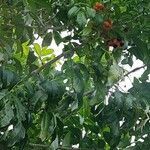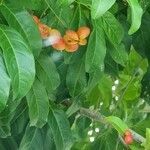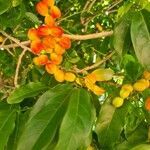(Shrub or) tree, up to 33 m high, dbh up to 60 cm, but usually much smaller. Young parts ± densely hirsute, hairs rather long; (on lower side of midrib, in inflorescences, and sepals also with longer glandular hairs). Twigs 3.5-9 mm thick. Leaves 2-6-jugate; petiole 4.5-15 cm long; petiolules 3-8 mm long; all axes hairy, glabrescent. Leaflets ovate to elliptic, 5.5-30 by 2-10 cm, index 1.5-3.5, herbaceous; base oblique with the upper half cordate or both sides acute, or symmetrical and acute to rounded; apex acute to rounded (to acuminate),-acumen usually short, acute; above glabrous but for the midrib, beneath glabrous or sparsely hairy on midrib and very sparsely so on the nerves; midrib above flat to slightly raised; nerves 0.75-2.25-cm apart, above flat; (intersecondary nerves inconspicuous). Inflorescences axillary to rami-or cau liflorous, hairy, ramified only near the base into several axes of about the same length, up to 17 cm long, or with a distinct, up to 35 cm (in fruit up to 60 cm) long main axis with short branches; pedicels in fruit 12-30 mm long. Sepals all equal, ovate to obovate, 5-10.5 by 3-5 mm, (some scattered glandular hairs especially along the margin). Petals: claw 3-7 mm long, blade obovate-oblong, 8-7 by 3-10 mm, white, outside glabrous or claw; and lower half of blade mainly in the centre sparsely hairy, margin often ciliate mainly in the basal part, inside often sparsely hairy. Disc sparsely to densely hairy. Stamens 5(-7); filaments 10-17 mm long; anthers 2-2.5 mm long. Pistil 2(-4)-locular; style 14-17 mm long; ovules 1 or 2 per locule. Fruits 9-31 by 27-65 mm; stipe up to 4.5(-7) mm high; lobes spreading, slender ellipsoid to globular; out-side prominently veined to smooth, red, fairly densely to sparsely hairy; wall thin, chartaceous to woody; inside reddish, sparsely hairy to glabrous. Seeds 1 or 2 per locule, black, mahogany-brown, or dark-purple; sarcotesta up to 2.5 mm wide, Orange.
More
Tree to 30 m high. Shoots brown-tomentose; branchlets, leaf axes and peduncles villous or glabrescent. Leaf rachis 4–22 cm long; leaflets 6–10, elliptic-oblong or obovate, acute to obtuse, entire, 10–19 cm long, 4–7.5 cm wide, glabrous except midrib and veins below hairy, thinly coriaceous; petiolules 4–6 mm long, tomentose; petiole 4–9 cm long. Inflorescence axillary or ramiflorous, 4–22 cm long, open, or of 2-or 3-flowered cymules. Pedicels 10–50 mm long, drooping. Sepals obovate, 6–7 mm long, membranous, tomentose. Petals clawed, 12–14 mm long, glabrous except claw. Disc hairy. Stamens 5. Ovary pubescent; style 10–15 mm long, twisted. Fruit broadly obcordate, 1.5–2.3 cm long, orange-yellow to red; lobes ellipsoidal or subglobose, reticulate, puberulent; valves drying ±woody, glabrescent or glabrous inside; sepals not persistent. Seed 1 per locule, shiny, black; aril minute or absent.
Usually well-drained primary forest, sometimes more open secondary formations; on ridges, slopes, and plains, in ravines, sometimes by or in swamps, on river banks, or by the coast, exceptionally in open vegetation; elevations up to 1,200 metres.
More
Usually grows in rainforest.
Uses The bark is used as a fish poison. A watery exudate of the bark and sometimes the fruits is used for washing, to keep away leeches, or is drunk to allay pain. For a description of the timber, see p. 427. The oil pressed out of the seeds is used as an anti-rheumatic. See Brown Useful Pl. Philipp. 2 1950 363 Desch Mal. For. Rec. 15 1954 528 (timber) .
Can be grown by seedlings. Seeds needs soaking.




